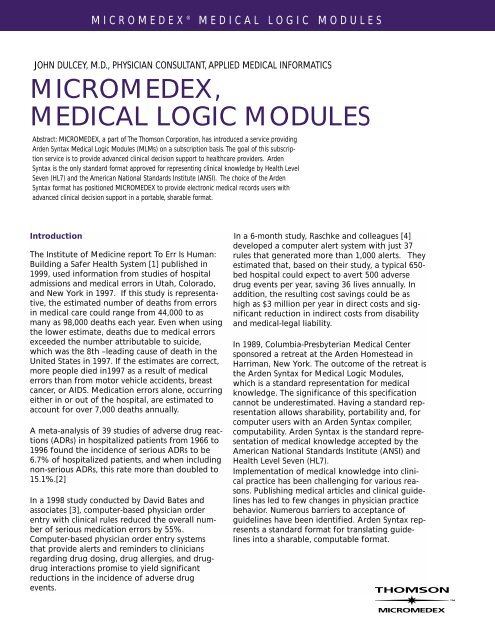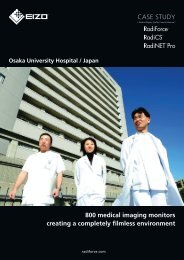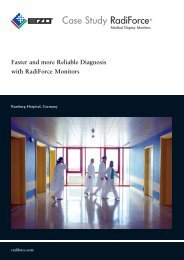Medical Logic Modules White Paper [PDF} - IDS-Healthcare
Medical Logic Modules White Paper [PDF} - IDS-Healthcare
Medical Logic Modules White Paper [PDF} - IDS-Healthcare
You also want an ePaper? Increase the reach of your titles
YUMPU automatically turns print PDFs into web optimized ePapers that Google loves.
MICROMEDEX ®MEDICAL LOGIC MODULESJOHN DULCEY, M.D., PHYSICIAN CONSULTANT, APPLIED MEDICAL INFORMATICSMICROMEDEX‚MEDICAL LOGIC MODULESAbstract: MICROMEDEX, a part of The Thomson Corporation, has introduced a service providingArden Syntax <strong>Medical</strong> <strong>Logic</strong> <strong>Modules</strong> (MLMs) on a subscription basis. The goal of this subscriptionservice is to provide advanced clinical decision support to healthcare providers. ArdenSyntax is the only standard format approved for representing clinical knowledge by Health LevelSeven (HL7) and the American National Standards Institute (ANSI). The choice of the ArdenSyntax format has positioned MICROMEDEX to provide electronic medical records users withadvanced clinical decision support in a portable, sharable format.IntroductionThe Institute of Medicine report To Err Is Human:Building a Safer Health System [1] published in1999, used information from studies of hospitaladmissions and medical errors in Utah, Colorado,and New York in 1997. If this study is representative,the estimated number of deaths from errorsin medical care could range from 44,000 to asmany as 98,000 deaths each year. Even when usingthe lower estimate, deaths due to medical errorsexceeded the number attributable to suicide,which was the 8th –leading cause of death in theUnited States in 1997. If the estimates are correct,more people died in1997 as a result of medicalerrors than from motor vehicle accidents, breastcancer, or A<strong>IDS</strong>. Medication errors alone, occurringeither in or out of the hospital, are estimated toaccount for over 7,000 deaths annually.A meta-analysis of 39 studies of adverse drug reactions(ADRs) in hospitalized patients from 1966 to1996 found the incidence of serious ADRs to be6.7% of hospitalized patients, and when includingnon-serious ADRs, this rate more than doubled to15.1%.[2]In a 1998 study conducted by David Bates andassociates [3], computer-based physician orderentry with clinical rules reduced the overall numberof serious medication errors by 55%.Computer-based physician order entry systemsthat provide alerts and reminders to cliniciansregarding drug dosing, drug allergies, and drugdruginteractions promise to yield significantreductions in the incidence of adverse drugevents.In a 6-month study, Raschke and colleagues [4]developed a computer alert system with just 37rules that generated more than 1,000 alerts. Theyestimated that, based on their study, a typical 650-bed hospital could expect to avert 500 adversedrug events per year, saving 36 lives annually. Inaddition, the resulting cost savings could be ashigh as $3 million per year in direct costs and significantreduction in indirect costs from disabilityand medical-legal liability.In 1989, Columbia-Presbyterian <strong>Medical</strong> Centersponsored a retreat at the Arden Homestead inHarriman, New York. The outcome of the retreat isthe Arden Syntax for <strong>Medical</strong> <strong>Logic</strong> <strong>Modules</strong>,which is a standard representation for medicalknowledge. The significance of this specificationcannot be underestimated. Having a standard representationallows sharability, portability and, forcomputer users with an Arden Syntax compiler,computability. Arden Syntax is the standard representationof medical knowledge accepted by theAmerican National Standards Institute (ANSI) andHealth Level Seven (HL7).Implementation of medical knowledge into clinicalpractice has been challenging for various reasons.Publishing medical articles and clinical guidelineshas led to few changes in physician practicebehavior. Numerous barriers to acceptance ofguidelines have been identified. Arden Syntax representsa standard format for translating guidelinesinto a sharable, computable format.
MICROMEDEX ®MEDICAL LOGIC MODULESGuideline developers can be divided into fourcategories [5]:• General medical societies• Subspecialty medical societies• Government agencies• Others (including individuals, insurers, andprivate organizations)Some electronic medical records and standaloneelectronic products have embedded guidelineswhich, at most, allow modification of parametersthat affect the guideline but in only limited waysthe logic of the guideline.At the Guideline Sharing Workshop, March 3-4,2000, Edward H. Shortliffe stated that guidelinescan be represented at any of three levels [6]:• Developer/viewer level• Abstract machine levels• Integration into application environmentsMICROMEDEX is synthesizing guidelines developedby trusted organizations and representingthem in Arden Syntax so that they can be integratedinto applications that customers can use.What makes the MICROMEDEX service unique isthat it addresses the abstract machine level andenables easier integration of medical knowledgeinto application environments.DiscussionImplementation of guidelines into practice hasbeen one of the most difficult problems, if notthe most difficult problem, related to guidelinedissemination. Hospitals and other healthcareenterprises, such as HMOs, have authored textbasedguidelines for physicians, nurses and pharmaciststo use in patient care, but the use ofthese guidelines in actual practice has been limitedby lack of clinician awareness. Putting analert or reminder directly into the workflowincreases the clinician’s awareness of the existenceof the guideline and enhances compliance.Guideline development requires considerableeffort. Hospitals and other healthcare enterpriseswill continue to develop local guidelines.However, there is considerable interest in takingguidelines developed by medical societies, governmentagencies and private organizations andimplementing those guidelines exactly as developed,or with only a few local modifications.MICROMEDEX has taken accepted guidelinesfrom trusted sources and expressed those guidelinesin Arden Syntax. In so doing, MICROMEDEXhas enabled hospitals and other healthcare enterprisesto implement those guidelines more quicklyand with less effort. But the greatest benefit tohealthcare enterprises will be in the maintenanceof the medical logic modules by MICROMEDEXwhen guidelines are updated.While there have been national efforts to gatherand centralize the available guidelines such asthe website for National GuidelineClearinghouse, there is still a need to synthesizethese guidelines and translate them into amachine-readable form. Development and maintenanceof any knowledge base is a formidabletask but is essential if the knowledge base is tohave and maintain relevance and validity. Makingguidelines available at the point of care whereand when they are needed will still require keenediting and implementation skills. One methodof doing this is by using a rules engine.A rules engine is a type of computer applicationthat applies rules to data to generate alerts andreminders for healthcare workers to followguidelines. Knowledge vendors are still neededto edit and translate guidelines into a format ofknowledge representation that can be used withrules engines in healthcare information systems.MICROMEDEX takes published guidelines andtranslates them for use within rules engines thatcan interpret Arden Syntax.Software vendors are reluctant to develop contentfor clinical decision support products. Theyview the development of content for clinicaldecision support a risky proposition, and outsidethe realm of their core competencies.MICROMEDEX has been developing knowledgebases and content for clinical decision support foryears with POISINDEX ® , DRUGDEX ® , and manyother products to support the clinical care ofpatients. It is a natural extension ofMICROMEDEX expertise to develop <strong>Medical</strong><strong>Logic</strong> <strong>Modules</strong> in Arden Syntax.
MICROMEDEX ®MEDICAL LOGIC MODULESMICROMEDEX currently offers three differentpackages of medical logic modules [7]. There is agold package, starter package, and a package ofwellness rules.Starter package (7 topics):• Lean Body Weight Calculator• Body Mass Index Calculator• Body Surface Area Calculator• Body Fluid Volumes Calculator• Creatinine Clearance Calculator/Monitor• Basal Energy Expenditure Calculator• Serum Osmolality CalculatorGold package (22 topics):• ANC Monitoring for Filgrastim (Neupogen)Therapy• Digoxin and Electrolytes• Dosing of Renally-Excreted Aminoglycosides• Dosing of Renally-Excreted Antivirals• Dosing of Renally-Excreted Betalactams• Dosing of Renally-Excreted Cephalosporins• Dosing of Renally-Excreted Fluoroquinolones• Dosing of Renally-Excreted Glycopeptides• Heparin Dosage Adjustment Suggestionsfor IV Infusion• Heparin Initial Dosage Suggestionsfor IV Infusion• Hypertensive Disease Management /Clinical Practice Guidelines• Antifungals IV-to-PO Conversion• Drug-Induced Hyperkalemia• Drug-Induced Hypokalemia• Drug-Induced Nephrotoxicity• Drug-Induced Thrombocytopenia• Drug-Induced Liver Injury• Fluoroquinolones IV-to-PO Conversion• H2-Receptor Antagonist IV to PO Conversion• IV-to-PO Cephalosporins Conversion• Appropriate Use of SupplementalIV Magnesium• Appropriate Use of SupplementalIV PotassiumWellness and Screening Package (9 topics):• Colorectal cancer screening• Breast cancer screening• Influenza screening• Cervical cancer screening• Pneumococcal immunization screening• High blood pressure screening• Cholesterol screening• Tetanus/diphtheria screening• Measles, mumps & rubella screeningThese sets range in complexity from the starterset, with relatively straightforward monitoringand screening, to rules for renal dosing of medicationswith complex absorption, bioavailabilityand excretion characteristics and narrow therapeuticindices. The development of the complexrules in the gold package draws on the expertisefor which MICROMEDEX is known. Most healthcareorganizations would not have the time ordepth of resources to create and maintain suchcomplex rules.One example of the forethought given to theMLM implementation process is the rule for creatinineclearance. The rule gives the user six differentformulas for creatinine clearance calculationfrom which to choose.Development and MaintenancePresently, the most common method of developmentof knowledge bases is through consensuspanels. These consensus panels serve as editorialboards that must determine when new knowledgerises to the level that a change must bemade to the knowledge base. MICROMEDEXdraws upon their clinical experts to contribute totheir editorial board.
MICROMEDEX ®MEDICAL LOGIC MODULESAdditionally, MICROMEDEX has assembled anexceptional Advisory Board consisting of pioneersin rule-based reminder systems. Robert Raschke,M.D., M.S., Robert Jenders, M.D., M.S., HarmScherpbier, M.D., and Carol Broverman, Ph.D.have been involved with the American Societyfor Testing and Materials (ASTM) and HealthLevel 7 (HL7) to help develop the standards forknowledge representation.When considering the knowledge represented bythe medical logic modules, the key determinantof quality is the strength of the developmentprocess. MICROMEDEX uses a defined processthat assigns an MLM author/developer and submitsthe draft MLM to internal and externalexperts for review. The MLM is then subjected toquality assurance (QA) functional and technicaltesting, including testing by the rules engine vendors.After release, the MLM undergoes a clientreview process and continued post-implementationevaluation.Long-term maintenance of a knowledge base fora clinical decision support system can involve aconsiderable number of changes. Jenders andassociates [8] reported that over a seven-yearperiod, more than 5,000 changes were made to aclinical decision support system knowledge base.<strong>Healthcare</strong> enterprises facing the long-termmaintenance effort find considerable value inhaving MICROMEDEX manage the maintenanceof this knowledge base.SummaryMICROMEDEX <strong>Medical</strong> <strong>Logic</strong> <strong>Modules</strong> written inArden Syntax provide health enterprises with areadily implementable knowledge base of decisionsupport rules. The task of developing andmaintaining knowledge bases is labor-intensive.While healthcare enterprises will continue todevelop their own rules, those using ArdenSyntax-based rules engines will speed the implementationprocess with the MICROMEDEX<strong>Medical</strong> <strong>Logic</strong> <strong>Modules</strong>. MICROMEDEX will maintainthe knowledge base with information fromtrusted sources on a regular schedule as newinformation is released from the guideline developmentorganizations. An additional strength ofthis concept is the open architecture of ArdenSyntax, which allows the client institution to customizethese rules to local needs and preferences.[1] Linda T. Kohn, Janet M. Corrigan, and Molla S.Donaldson, Editors; To Err Is Human: Building a SaferHealth System, Committee on Quality of Health Carein America, Institute of Medicine.[2] Lazarou J, Pomeranz BH and Corey PN: Incidence ofadverse drug reactions in hospitalized patients – Ameta-analysis of prospective studies. JAMA 1998;279(15):1200-5.[3] Bates DW et al., Effect of computerized physicianorder entry and a team intervention on prevention ofserious medication errors, JAMA 1998; 280:1311-16.[4] Raschke RA et al., A Computer Alert System toPrevent Injury From Adverse Drug Events, JAMA 1998,280:1317-20.[5] Shaneyfelt TM, Mayo-Smith MF, Rothwangl J Areguidelines following guidelines? The methodologicalquality of clinical practice guidelines in the peerreviewedmedical literature. JAMA 1999 May 26;281(20): 1900-5.[6] Shortliffe, E, Toward a Sharable GuidelineRepresentation, An Invitational Workshop: TowardsRepresentations for Sharable Guidelines, March 3 - 4,2000, Boston, Massachusetts.[7] MICROMEDEX® <strong>Medical</strong> <strong>Logic</strong> <strong>Modules</strong>, accessedon 12.9.2000.[8] Jenders RA, Evolution of a Knowledge Base for aClinical Decision Support System Encoded in ArdenSyntax. Proceedings AMIA Annual Symposium 1998:558-562.Dr. Dulcey writes medical logic modules and consultsfor healthcare enterprises implementing clinical decisionsupport systems that use Arden Syntax. He hassixteen years of clinical experience as a generalinternist and worked for Siemens Health Solutionsdeveloping and implementing the Siemens RulesEngine. Dr. Dulcey is a member of the Clinical DecisionSupport Committee and the Arden Syntax SpecialInterest Group of Health Level 7. He can be reached atjohn.dulcey@alum.mit.edu.(800) 525-9083Intl Tel +1 303 486 6444www.micromedex.comAll MICROMEDEX Systems are Copyright © 1974-2002 MICROMEDEX Thomson <strong>Healthcare</strong>.All rights reserved. All product and brand names are trademarks or registered trademarks of their respective companies.HC-15738 MLM Dulcey paper 08/02




